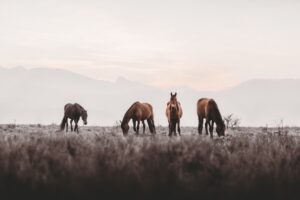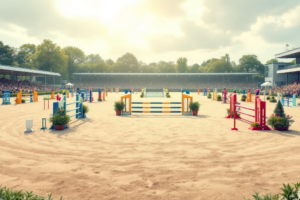“This is the year I’m going to take my riding to the next level.”
“I’m going to really focus on my riding this year.”
“This year I’m going to really take my riding where I’ve always wanted it to go.”
“I am really going to do it this year, I’m going to enter the local eventing/show jumping/dressage event!”
How many of us earnestly say a version of these words at the start of every season? Whether you are already competing and winning at the level you currently ride at, or whether getting to the show ring seems a far off pipe dream, or possibly even a bit of a nightmare, many of us have aspirational thoughts about getting better at our riding. Often, we start the new year or new season very inspired and motivated. We may even really up the ante in the saddle for a few weeks or so, and we often tell our instructors that these are the plans. And most of us do in fact improve moderately every year, moving up a grade here and there.
But how many of us can identify with the sentiment that we are just repeating the same few weeks of extra motivated riding every year, without really adopting the mindset of the rider we want to become? How many of us are “drifters”, content to work at the same sort of level, year after year, convincing ourselves that we don’t really want to jump in the 120’s, or that higher level dressage is just too hard for the average horse and rider combination?
How many of us WRITE DOWN our goals and then keep notes about our progress?
According to the best research, less than 3 percent of Americans have written goals, and less than *1 percent review and rewrite their goals on a daily basis.
Yet studies have consistently shown that writing down your goals in any given area offers a *42% better chance of reaching them!
Neuroscience explains this phenomenon as follows: Firstly, the external storage aspect of keeping information in a place where you are able to access and review it at any time. If you’re looking at it every day, you will remember it better.
Secondly, the biological process called encoding, is where we send information to our brain’s hippocampus (the memory centre), where is is analyzed and sorted. Your brain decides what to store in your long-term memory and what to discard. Writing greatly improves this encoding process, so goals that are written down have a much greater chance of being remembered.
Trifocus Fitness Accademy states in their Sport Pschology course that teaching a performer how to set short-term and long-term goals and how to evaluate progress toward them is an extremely powerful technique for enhancing performance, making it one of the most important strategies you can implement for success in any environment!
Ok then, how should we go about Goal Setting for our riding?
Wanting to win is a very common outcomes based goal. Most competitive riders strive to do their very best at shows, and for most, that means bringing home the trophy. Obviously, that would be awesome. But its an outcomes focussed goal that is not within our control to achieve. What if someone else rides better than you? Takes a tighter turn? Scores higher on several movements? What if you and your horse are just not ready today? When you set your heart on winning and you don’t, the disappointment can be devastating. Equally, if your only goal is winning, and you do win every time, the victory becomes hollow and meaningless very quickly.
If we turn our attention to two other types of goals, we find that
- Process goals are the actions needed to execute the goal correctly, and
- Performance goals are set standards that need to be reached.
A process goal is something you have control over, and want to practice getting better at.
Keeping your lower leg still and your weight over the correct seat bone when executing a half pass, or riding smoother rounds by giving a better, clearer aid for landing on the correct lead are examples of process goals that you can use to build a picture of how your riding is improving, day by day. These goals hold YOU accountable for doing the right work, piece by piece, to put together your best possible ride, on the day.
When you combine this with performance goals, which are the standards required at your level of riding or competing, you can really start building a solid evidence portfolio of what you are doing well on each ride, as well as the thing you are working on to improve. An example of a performance goal in dressage would be to improve your seat at sitting trot in order to be able to correctly ride movements in tests from elementary level. You would set a process goal of strengthening your core muscles first, then move towards a performance goal of being able to complete your test trot work in sitting trot, then ultimately, you would be ready for the final outcome goal of winning the class!
No matter how you do at the show, you can check yourself against your own goals as well as the set standards for improvements, and gradually, as you keep working on those small things, that add up to become the big things, you will be able to tick off your own goals achieved.
Here’s the formula: Process + Performance = Outcome
Most important – write down these goals! Spend a bit of time right now, thinking about your riding and the areas that you most want to improve in. Then write up a plan for reaching those goals. Here are a few suggestions, to get you thinking….
Lack confidence? Arrive at shows terrified and flustered?
Start your goals with practicing calm focus at home. Your process goal could be that you learn a breathing technique, or practice mindful meditation before bed. As you notice how well that is working, you begin to set performance goals like: entering the small, local show and practicing your new behaviors in a slightly more stressful, but not terrifying, environment.
Want to jump up a level this year, but haven’t quite mastered the level you’re at now?
Write down honestly what you do really well at your current level, and also the skills you need to work on to improve. Then set your process goals: I need to keep my heels deeper over fences, so that my body doesn’t tip too far forward. I will practice the movement unmounted every day, and also do exercises to strengthen my calves. Then, into performance: challenge yourself to jump each round with deep heels as your main goal. Notice how this affects your position, and your round.
The key is to keep writing. Keeping a Rider Journal where you log your own goals, feelings, hopes and fears can really help you to become a goal setting guru. People who set goals in writing, and take small steps every day in pursuit of their dreams, find that they often exceed their own expectations, and they also have a clearer picture of where they’re going, and how to get there.
Forging Ahead Coaching
Linda Hennings
Facebook: Forging Ahead Coaching (https://web.facebook.com/ForgingAheadSA)
Website: https://forgingahead.co.za/
References
- www.briantracy.com Success through goal setting
- www.inc.com This is the way you need to write down your goals

















